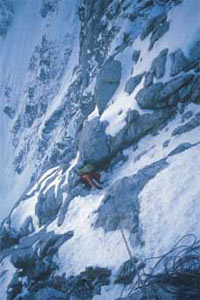
Guy Willett enjoying Scottish conditions on the Great White Fright (ED, 6,000′, Ramsden-Willett, 2003) on Denali?s Father and Sons Wall. [Photo] Paul Ramsden
Paul Ramsden and I studied the 6,000-foot Father and Sons Wall while acclimatizing on the West Buttress. The face had already been climbed twice, both times in impressive single pushes. However, we thought there was room for another line to the right of First Born (Alaska Grade V, 6,000′, Helmuth-House, 1995). This line would follow a natural line of weakness that began a short way up the “death gully.”
With a twenty-four- to thirty-six-hour weather window forecast, we stripped down our packs to the bare minimum. We set off at 8 p.m. from 11,000 feet on the West Buttress Route with one rucksack that held two duvets, mitts, six tortillas, twenty chocolate bars and a stove. To reach the base of the route, we dropped 3,000 feet in five hours into the Lower Peters Glacier. The hanging serac of the Upper Peters Glacier (“the Howitzer”) let loose just as we were most committed. The avalanche somehow swept over us without dislodging us from our precarious stances. Pleased to be alive, we quickened the pace and made it halfway up the face before stopping for mid-afternoon tea and to avoid the snow- and rockfall caused by the warm temperatures. We began again when the face had refrozen and dispatched the remainder of the route by around lunchtime the next day. Toward the top the pace became painfully slow and hallucinations frequent, so we stopped for more tea partway across the Upper Peters Glacier. Several hours of knee-deep breakable crust saw us at the top of the fixed ropes at 16,000 feet on the West Buttress Route, from which we made an easy descent to the 14,200-foot camp.
The Great White Fright (ED, 6,000′) took us fifty hours roundtrip. The climbing was quite moderate for the most part with several pitches of Scottish V in each of the three rock bands providing interest.
– Guy Willett, Barnard Castle, United Kingdom